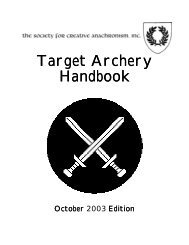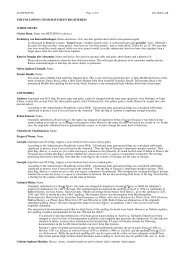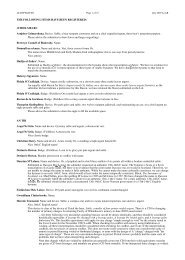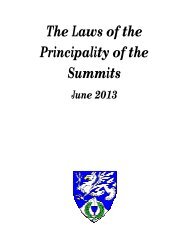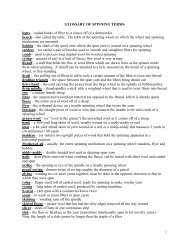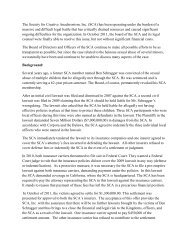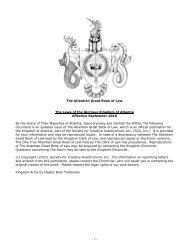The Standards for Evaluation of Names and Armory - SCA Heraldry
The Standards for Evaluation of Names and Armory - SCA Heraldry
The Standards for Evaluation of Names and Armory - SCA Heraldry
Create successful ePaper yourself
Turn your PDF publications into a flip-book with our unique Google optimized e-Paper software.
<strong>The</strong> <strong>St<strong>and</strong>ards</strong> <strong>for</strong> <strong>Evaluation</strong> <strong>of</strong> <strong>Names</strong> <strong>and</strong> <strong>Armory</strong>:<strong>The</strong> Rules <strong>for</strong> Submissionsb. Mixing Ordinaries <strong>and</strong> Other Charges: While charge groups may have different types <strong>of</strong> charges,charge groups consist <strong>of</strong> either identical ordinaries or complex charges. Thus, a single charge group maynot mix ordinaries with non-ordinaries or mix two types <strong>of</strong> ordinaries.For example, a design like Or, in pale an acorn proper <strong>and</strong> a bar gules or Sable, in pale a fess <strong>and</strong> achevron would not be registered. However, such mixtures <strong>of</strong> charges can be found in entire designs <strong>and</strong>can be registerable. For example, Azure, a chevron argent between three sea-horses <strong>and</strong> a chief Or isregisterable, consisting <strong>of</strong> a primary chevron <strong>and</strong> two secondary charge groups. Similarly, Gules, a fessbetween two chevrons argent is registerable; the fess is primary <strong>and</strong> the chevrons secondary.c. Unity <strong>of</strong> Posture <strong>and</strong> Orientation: <strong>The</strong> charges within a charge group should be in either identicalpostures/orientations or an arrangement that includes posture/orientation (in cross, combatant, or in pallpoints outward, <strong>for</strong> example). A charge group in which postures <strong>for</strong> different charges must be blazonedindividually will not be allowed without period examples <strong>of</strong> that combination <strong>of</strong> postures. Arrangements<strong>of</strong> charges which cannot be blazoned will not be allowed. Some st<strong>and</strong>ard arrangements <strong>for</strong> period chargegroups are discussed in Appendix K.For example, a design such as Argent, two lions passant respectant <strong>and</strong> a lion statant erect affronty vertwould not be allowed. Likewise, a design such as Azure, two pheons bendwise, <strong>and</strong> a pheon inverted Orwould not be allowed. However, crescents, increscents, decrescents, <strong>and</strong> crescents pendant were usedoccasionally in the same armory, so armory which includes more than one <strong>of</strong> these is allowed.d. Allowable Differences within Charge Groups: Some differences are found in period amongst chargeswithin a charge group. Thus, we allow some differences within a charge group, as long as they remainblazonable. This includes the changes to the tincture <strong>of</strong> charges (including partitions) within a chargegroup, <strong>and</strong> a tertiary charge group that is only found on part <strong>of</strong> a group <strong>of</strong> charges. Other changes notdiscussed here are generally assumed to be allowable.E. Armorial Simplicity: Period armory was mostly simple in nature, having only a few charge groups on thefield <strong>and</strong> a few tinctures.1. Arrangement <strong>of</strong> Charge Groups: Charge groups must be arranged upon the field in a period fashion.Appendix J gives lists <strong>of</strong> those arrangements <strong>of</strong> charge groups which do not need further documentation.All arrangements <strong>of</strong> two or fewer charge groups on the field are considered compatible with period style,except <strong>for</strong> those listed as not documented in Appendix J. Only a limited number <strong>of</strong> arrangements <strong>of</strong> threeor more charge groups on the field are documented; those are listed in Appendix J. Other arrangements <strong>of</strong>charge groups must be documented.2. Complexity Count: We require that any submission not exceed a certain "complexity count," measured byadding the number <strong>of</strong> types <strong>of</strong> charges to the number <strong>of</strong> tinctures. Items with a complexity count <strong>of</strong> eight orless receive no penalty <strong>for</strong> complexity from this rule. Furs, such as ermine <strong>and</strong> vair, count as a singletincture rather than their component tinctures. Charges that have different names in different tinctures ororientations (roundels, crescents, gouttes) are considered one type regardless <strong>of</strong> the term used <strong>for</strong> them. Allcharges, including maintained charges, are counted, though objects worn by an animal or person do not. Alltinctures are counted except those used only <strong>for</strong> normally unblazoned artistic details like teeth, claws, <strong>and</strong>eyes. Proper is not a tincture, but a description <strong>of</strong> a group <strong>of</strong> tinctures, each <strong>of</strong> which is counted separately.For example, Vert, in fess two straight trumpets palewise Or <strong>and</strong> a chief argent has a complexity count <strong>of</strong>five, while Vert, in fess two straight trumpets palewise <strong>and</strong> a chief Or has a complexity count <strong>of</strong> four. Vair,a squirrel gules has a complexity count <strong>of</strong> three. Argent, a brown monkey proper vested gules has acomplexity count <strong>of</strong> four, because the tincture <strong>of</strong> the vest is also counted. For example, a rose proper has<strong>St<strong>and</strong>ards</strong> <strong>for</strong> <strong>Evaluation</strong> <strong>of</strong> <strong>Names</strong> <strong>and</strong> <strong>Armory</strong> – April 29, 2012 - Page 46 <strong>of</strong> 73



